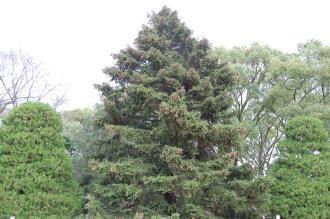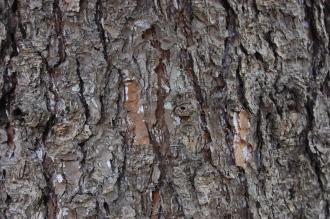
Picea torano (04/04/2015, Kyoto Botanic Gardens, Kyoto, Japan)
Position: Full sun to light shade
Flowering period: Late spring
Soil: Moist, well drained
Eventual Height: 30m
Eventual Spread: 8m
Hardiness: 6a, 6b, 7a, 7b, 8a, 8b
Family: Pinaceae
Picea torano is an evergreen conifer tree with an upright, pyramidal habit. Its dark green leaves are needle like, up to 2cm long and 2.5mm across. Its grey/ brown bark is smooth when young and deeply fissure and flaking with age. Its trunk may achieve a diameter of up to 1m. Its monoecious flowers are wind pollinated, the male initially red/ purple and 3cm tall, the female ovate and green. Its red/ brown cones are up to 11cm long an 4.5cm across.

Picea torano Leaf (04/04/2015, Kyoto Botanic Gardens, Kyoto, Japan)
Picea torano, commonly known as Tigertail Spruce, is native to Japan. In its native habitat it grows as part of mixed woodland in a cool and moist maritime climate at an elevation of 600-1700m. Picea torano is synonymous with Picea polita. Picea torano is classified as Vulnerable in its native habitat according to the IUCN Red List of Threatened Species.
The etymological root of the binomial name Picea is derived from the Lain Pix meaning ‘pitch or tar’ in reference to the Spruce trees resin. Torano is from the Japanes vanacular toran-wo meaning ‘tiger’s tail’.
The landscape architect may find Picea torano useful as a large evergreen specimen tree which is suitable for wet climates.

Picea torano Bark (04/04/2015, Kyoto Botanic Gardens, Kyoto, Japan)
Ecologically, Picea torano seeds are attractive to some birds and mammals.
Picea torano prefers moist, humus rich fertile, well-drained soils. It will tolerate most pH of soil and prefers acidic soils.
Picea torano requires little maintenance.

Landscape Architecture

